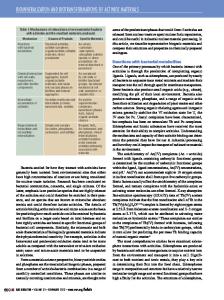Challenges in Plutonium and Actinide Materials Science
- PDF / 1,275,621 Bytes
- 5 Pages / 612 x 792 pts (letter) Page_size
- 29 Downloads / 351 Views
Challenges in
Plutonium and Actinide Materials Science Louis J.Terminello, Guest Editor
There are perhaps no more controversial materials in our society than the actinides— the elements above actinium in the periodic table that include uranium, plutonium, and many other radioactive elements. They are at the same time vilified by some for their potentially catastrophic impact on the environment and global health and praised by others for their role in ending the Cold War.1 And yet, at the heart of both these issues is a tremendous amount of fundamental research and technology that is essential for the actinides’ rational use, safe disposition, reliable long-term storage, and the remediation of their impact on the environment. Of all the actinides, plutonium is the most notorious, and deserves particular attention here due to its peculiarities, uses, and societal impact. Central to plutonium’s strategic military and nuclear-power uses has been the novel nuclear properties (the fission chain reaction) of several of its isotopes. However, this fissionable element is also a remarkable material with unusual properties and behavior.2,3 It is important to note that despite the scientific curiosity regarding this material, the study of plutonium is compromised by its radioactive properties and acute toxicity; only the brave, determined, and heavily protected even attempt to work with it. Few elements in the periodic table have a birth date. Plutonium’s entry into our world took place at the University of California—Berkeley on February 23, 1941, when the legendary Glenn T. Seaborg, and his colleagues Edwin McMillan, Joseph Kennedy, and Arthur Wahl, first synthesized and identified (“discovered”) atomic number 94. In spite of the 50-plus years of research on plutonium metal, alloys, and compounds, there are still many un-
MRS BULLETIN/SEPTEMBER 2001
answered questions regarding this most unusual material. The materials science and technology of plutonium continue to raise many important questions.4,5 Recent work on the environmental aspects of plutonium reactivity and transport in groundwater by new methods surprised many.6,7 Since 1945, many nations have used actinides as a strategic component of nuclear weapons, as a fuel for energy production in nuclear-power reactors, and energy sources for satellites and deep-space probes. Tons of the material have been produced for nuclear weapons and as a by-product of nuclear reactors. Regardless of whether one supports the Cold War buildup and the use of actinides in the nuclear stockpile or in the generation of nuclear power, uranium, plutonium, their compounds, and other radiotoxic actinides are with us to stay and must be dealt with in the most rational fashion possible. Only with the best technical and scientific information regarding the actinides can our society develop a reasonable path forward for using, storing, and cleaning up these materials. Thus, we have the motivation for presenting some of the research on actinides, with an emphasis on plutonium, through the artic
Data Loading...











